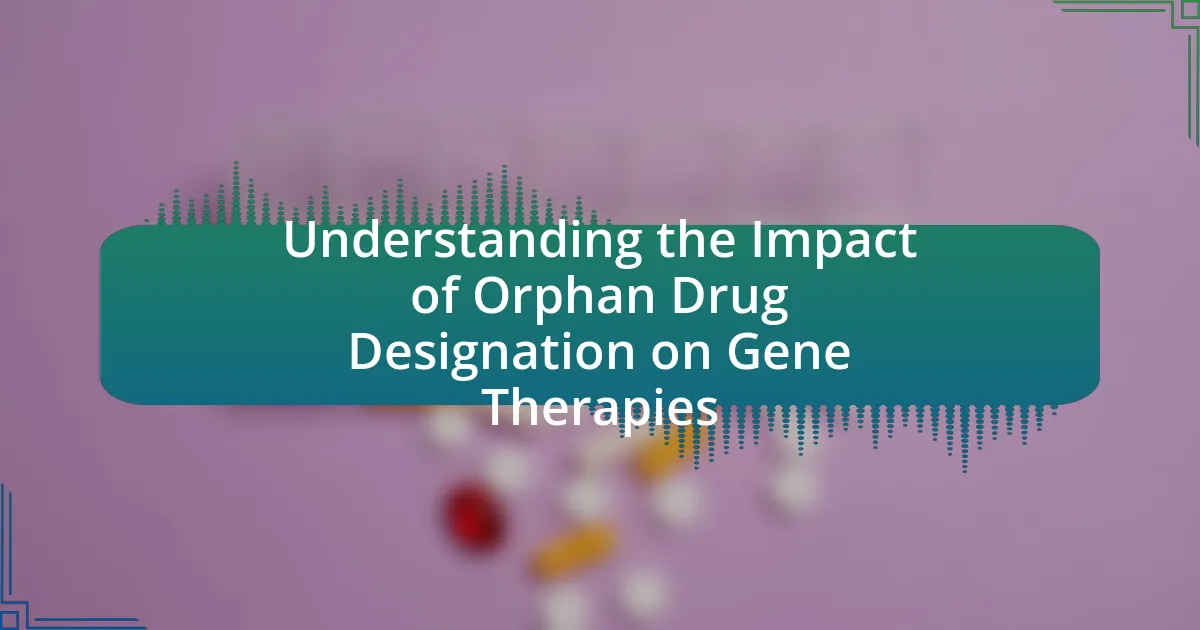The Center for Biologics Evaluation and Research (CBER) is a division of the FDA responsible for regulating biological products, particularly cell and gene therapies. CBER’s oversight includes evaluating the safety, efficacy, and quality of these therapies through rigorous review processes, including clinical trial assessments and post-market surveillance. The article outlines CBER’s key responsibilities, the regulatory frameworks it employs, and the importance of its oversight for public health. Additionally, it addresses the challenges CBER faces in adapting to rapid advancements in technology and the ethical considerations involved in regulating innovative therapies.

What is CBER and its Role in Cell and Gene Therapy Oversight?
CBER, or the Center for Biologics Evaluation and Research, is a division of the FDA responsible for regulating biological products, including cell and gene therapies. CBER’s role in cell and gene therapy oversight involves evaluating the safety, efficacy, and quality of these therapies before they can be marketed. This includes reviewing clinical trial data, manufacturing processes, and labeling to ensure compliance with regulatory standards. CBER also provides guidance to developers on regulatory requirements and monitors post-market safety to protect public health.
How does CBER contribute to the regulation of cell and gene therapies?
CBER, the Center for Biologics Evaluation and Research, contributes to the regulation of cell and gene therapies by overseeing the safety, efficacy, and quality of these products through a rigorous review process. This includes evaluating clinical trial data, manufacturing practices, and post-market surveillance to ensure compliance with regulatory standards. CBER’s role is critical as it establishes guidelines and frameworks, such as the guidance documents for gene therapy products, which outline the necessary preclinical and clinical data required for approval. Additionally, CBER engages in scientific collaboration and public outreach to enhance understanding and compliance within the industry, thereby ensuring that cell and gene therapies are developed and administered safely to patients.
What are the key responsibilities of CBER in this context?
The key responsibilities of the Center for Biologics Evaluation and Research (CBER) in the context of cell and gene therapy oversight include ensuring the safety, efficacy, and quality of biologics. CBER evaluates investigational new drug applications (INDs) for cell and gene therapies, conducts premarket reviews, and monitors post-market safety through adverse event reporting. Additionally, CBER provides guidance to manufacturers on regulatory requirements and compliance, facilitating the development and approval processes for innovative therapies. These responsibilities are critical for protecting public health and ensuring that new treatments meet established standards before reaching patients.
How does CBER ensure the safety and efficacy of these therapies?
CBER ensures the safety and efficacy of therapies by conducting rigorous evaluations of clinical trial data and manufacturing processes. This includes reviewing preclinical studies, clinical trial protocols, and results to assess potential risks and benefits. CBER also mandates compliance with Good Manufacturing Practices (GMP) to ensure that products are consistently produced and controlled according to quality standards. Additionally, CBER monitors post-market safety through adverse event reporting systems, allowing for ongoing assessment of therapy performance in real-world settings. These measures are supported by regulatory frameworks established under the Federal Food, Drug, and Cosmetic Act, which require thorough scientific evaluation before therapies can be approved for public use.
Why is CBER’s oversight important for public health?
CBER’s oversight is crucial for public health because it ensures the safety, efficacy, and quality of biological products, including cell and gene therapies. This regulatory framework protects patients from potential risks associated with these advanced therapies, which can have significant implications for health outcomes. For instance, CBER evaluates clinical trial data and manufacturing processes to prevent adverse effects and ensure that treatments meet established standards. By maintaining rigorous oversight, CBER helps to foster public trust in innovative therapies, ultimately contributing to improved health and well-being in the population.
What risks are associated with unregulated cell and gene therapies?
Unregulated cell and gene therapies pose significant risks, including safety concerns, lack of efficacy, and potential for harmful side effects. Safety concerns arise from the absence of rigorous testing, which can lead to adverse reactions such as immune responses or tumor formation. Lack of efficacy is a risk because therapies may not deliver the promised benefits, resulting in wasted resources and patient harm. Additionally, the potential for harmful side effects can include unintended genetic modifications that may affect not only the patient but also future generations. These risks underscore the necessity for regulatory oversight to ensure the safety and effectiveness of such therapies.
How does CBER mitigate these risks through its oversight?
CBER mitigates risks through its oversight by implementing rigorous regulatory frameworks and comprehensive review processes for cell and gene therapies. These frameworks include pre-market evaluations, post-market surveillance, and adherence to Good Manufacturing Practices (GMP), which ensure that products are safe, effective, and manufactured consistently. For instance, CBER conducts thorough assessments of clinical trial data to evaluate the safety and efficacy of therapies before they reach the market, thereby reducing the likelihood of adverse effects. Additionally, CBER monitors ongoing clinical trials and post-marketing data to identify any emerging safety concerns, allowing for timely interventions. This proactive approach is supported by the FDA’s authority under the Federal Food, Drug, and Cosmetic Act, which mandates that all biological products meet stringent safety and efficacy standards.

What are the Regulatory Frameworks CBER Uses?
The Center for Biologics Evaluation and Research (CBER) utilizes several regulatory frameworks, primarily the Federal Food, Drug, and Cosmetic Act (FDCA) and the Public Health Service Act (PHSA). These frameworks govern the approval and oversight of biologics, including cell and gene therapies. The FDCA provides the foundation for the regulation of drugs and biologics, while the PHSA specifically addresses the regulation of biological products to ensure their safety, efficacy, and quality. CBER also adheres to guidelines set forth by the Code of Federal Regulations (CFR), particularly Title 21, which outlines the specific requirements for biologics.
What guidelines does CBER follow for cell and gene therapy products?
CBER follows specific guidelines for cell and gene therapy products as outlined in the FDA’s “Guidance for Industry: Gene Therapy for Rare Diseases” and “Guidance for Industry: Human Gene Therapy for Diseases.” These guidelines emphasize the need for comprehensive preclinical data, including safety and efficacy studies, to support Investigational New Drug (IND) applications. Additionally, CBER requires adherence to Good Manufacturing Practices (GMP) to ensure product quality and consistency. The guidelines also address the importance of long-term follow-up for patients receiving these therapies to monitor for potential adverse effects, thereby reinforcing the regulatory framework that governs the development and approval of cell and gene therapies.
How do these guidelines differ from traditional drug regulations?
These guidelines differ from traditional drug regulations primarily in their focus on the unique characteristics and complexities of cell and gene therapies. Traditional drug regulations typically emphasize chemical compounds and their pharmacokinetics, while the new guidelines address the biological nature of living cells and genetic material, requiring a more nuanced approach to safety and efficacy assessments. For instance, traditional regulations often rely on standardized clinical trial designs, whereas the guidelines for cell and gene therapies advocate for tailored trial designs that consider the specific mechanisms of action and patient populations involved. This shift reflects the need for adaptive regulatory frameworks that can accommodate the rapid advancements in biotechnology and the distinct challenges posed by these innovative therapies.
What role do clinical trials play in CBER’s regulatory process?
Clinical trials are essential in CBER’s regulatory process as they provide the necessary data to evaluate the safety and efficacy of biological products, including cell and gene therapies. CBER, which is part of the FDA, relies on the results from these trials to make informed decisions regarding product approvals and market access. Specifically, clinical trials generate evidence that demonstrates how a product performs in human subjects, which is critical for assessing potential risks and benefits. This data is then reviewed by CBER to ensure compliance with regulatory standards, ultimately guiding the approval process for new therapies.
How does CBER interact with other regulatory bodies?
CBER interacts with other regulatory bodies through collaboration and information sharing to ensure the safety and efficacy of cell and gene therapies. This interaction includes partnerships with the FDA, NIH, and international organizations such as the European Medicines Agency (EMA) to harmonize regulatory standards and facilitate the approval process for new therapies. For instance, CBER participates in the FDA’s inter-center consultative processes, which involve multiple divisions working together on complex products, thereby enhancing regulatory efficiency and scientific expertise.
What is the significance of collaboration with international agencies?
Collaboration with international agencies is significant because it enhances the regulatory framework and promotes the safe development of cell and gene therapies. By working together, agencies can share best practices, harmonize standards, and facilitate the exchange of scientific knowledge, which is crucial for addressing global health challenges. For instance, the International Conference on Harmonisation (ICH) has established guidelines that help ensure the safety and efficacy of therapies across different countries, thereby streamlining the approval process and fostering innovation. This collaborative approach ultimately leads to improved patient outcomes and more efficient use of resources in the field of cell and gene therapy.
How does CBER coordinate with the FDA and other stakeholders?
CBER coordinates with the FDA and other stakeholders through collaborative frameworks that facilitate communication and regulatory alignment. This includes participation in inter-agency meetings, sharing scientific data, and engaging in public workshops to gather input from industry and academia. For instance, CBER’s involvement in the FDA’s Office of Tissues and Advanced Therapies ensures that regulatory policies are consistent and informed by the latest scientific advancements. Additionally, CBER collaborates with external stakeholders, such as patient advocacy groups and industry representatives, to address concerns and improve the regulatory process for cell and gene therapies.

What Challenges Does CBER Face in Oversight?
CBER faces several challenges in oversight, primarily due to the rapid advancement of cell and gene therapies. These therapies often involve complex biological products that require specialized knowledge for effective regulation. Additionally, CBER must navigate the evolving scientific landscape, which includes emerging technologies and methodologies that may not fit within existing regulatory frameworks. For instance, the rise of CRISPR and other gene-editing technologies presents unique safety and efficacy concerns that require updated guidelines and evaluation processes. Furthermore, CBER deals with resource constraints, including staffing and funding, which can limit its ability to conduct thorough reviews and inspections. These challenges are compounded by the need for collaboration with other regulatory bodies and stakeholders to ensure comprehensive oversight while fostering innovation in the field.
What are the emerging trends in cell and gene therapy that impact oversight?
Emerging trends in cell and gene therapy that impact oversight include the increasing use of advanced manufacturing technologies, the rise of personalized medicine, and the integration of real-world evidence in regulatory decision-making. Advanced manufacturing technologies, such as automated cell processing and gene editing tools like CRISPR, enhance product consistency and safety, necessitating updated regulatory frameworks to ensure compliance. Personalized medicine trends require oversight bodies to adapt to individualized treatment protocols, which may complicate traditional regulatory pathways. Additionally, the incorporation of real-world evidence, derived from patient data and post-market studies, is becoming crucial for evaluating long-term safety and efficacy, prompting regulatory agencies to refine their assessment criteria. These trends collectively challenge existing oversight mechanisms and demand a more agile regulatory approach to ensure patient safety while fostering innovation.
How do advancements in technology challenge existing regulations?
Advancements in technology challenge existing regulations by outpacing the frameworks designed to govern them, leading to gaps in oversight and compliance. For instance, the rapid development of gene editing technologies, such as CRISPR, has raised questions about safety, efficacy, and ethical considerations that current regulations do not adequately address. The U.S. Food and Drug Administration (FDA) and the Center for Biologics Evaluation and Research (CBER) are tasked with ensuring that therapies are safe and effective; however, the speed of innovation often results in a lag in regulatory updates. This discrepancy can lead to unregulated or poorly regulated products entering the market, potentially compromising patient safety and public trust.
What ethical considerations arise in the oversight of these therapies?
Ethical considerations in the oversight of cell and gene therapies include informed consent, equitable access, and long-term safety monitoring. Informed consent ensures that patients fully understand the risks and benefits of these therapies before participation, as highlighted by the Belmont Report, which emphasizes respect for persons. Equitable access addresses disparities in treatment availability, ensuring that marginalized populations are not excluded from potentially life-saving therapies. Long-term safety monitoring is crucial due to the unknown effects of genetic modifications, as evidenced by the FDA’s requirement for post-market surveillance to track adverse events. These considerations are essential for maintaining public trust and ensuring ethical standards in the rapidly evolving field of gene therapy.
How can CBER improve its oversight processes?
CBER can improve its oversight processes by enhancing its risk-based assessment framework for cell and gene therapies. This approach allows for more efficient allocation of resources and prioritization of products based on their potential risks and benefits. For instance, the FDA’s 2020 guidance on the use of real-world evidence in regulatory decision-making supports the integration of post-market surveillance data, which can inform ongoing oversight and safety monitoring. By adopting such evidence-based practices, CBER can ensure that its oversight processes remain adaptive and responsive to emerging data and technologies in the rapidly evolving field of cell and gene therapy.
What best practices can be adopted for more effective regulation?
Best practices for more effective regulation in the context of cell and gene therapy oversight include establishing clear guidelines, enhancing stakeholder engagement, and utilizing adaptive regulatory frameworks. Clear guidelines ensure that all parties understand the requirements and expectations, which can reduce ambiguity and improve compliance. Enhanced stakeholder engagement, including collaboration with industry, patient advocacy groups, and scientific communities, fosters transparency and trust, leading to more informed decision-making. Utilizing adaptive regulatory frameworks allows for flexibility in response to emerging technologies and scientific advancements, ensuring that regulations remain relevant and effective. These practices are supported by the FDA’s commitment to innovation while safeguarding public health, as seen in their guidance documents and collaborative initiatives.
How can stakeholder engagement enhance CBER’s oversight capabilities?
Stakeholder engagement can enhance CBER’s oversight capabilities by fostering collaboration and information sharing among diverse parties involved in cell and gene therapy. This engagement allows CBER to gather insights from industry experts, patient advocates, and healthcare professionals, which can inform regulatory decisions and improve the evaluation of therapies. For instance, active dialogue with stakeholders can lead to the identification of emerging safety concerns or efficacy issues that may not be apparent through traditional data sources. Additionally, stakeholder feedback can help CBER align its regulatory framework with real-world applications, ensuring that oversight practices are relevant and effective in addressing the complexities of innovative therapies.
What are the best practices for navigating CBER’s oversight?
The best practices for navigating CBER’s oversight include thorough understanding of regulatory requirements, proactive communication with CBER, and comprehensive documentation of all processes. Understanding regulatory requirements ensures compliance with the FDA’s guidelines for cell and gene therapies, which are critical for successful product development. Proactive communication with CBER fosters a collaborative relationship, allowing for clarification of expectations and timely feedback. Comprehensive documentation serves as a record of compliance and facilitates transparency during inspections and reviews. These practices are essential for minimizing delays and ensuring a smoother regulatory process, as evidenced by successful case studies where companies effectively engaged with CBER throughout their product development lifecycle.



